最新牛津英语五年级下册英语语法知识汇总-(1)
牛津五年级英语语法大全新
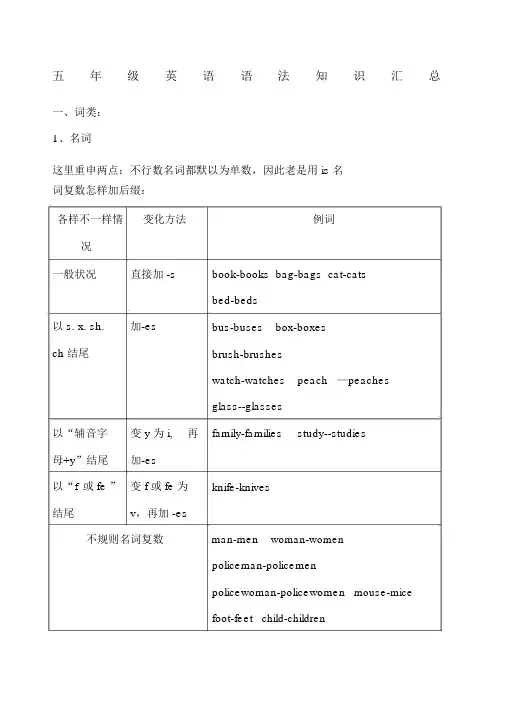
五年级英语语法知识汇总一、词类:1、名词这里重申两点:不行数名词都默以为单数,因此老是用 is 名词复数怎样加后缀:各样不一样情变化方法例词况一般状况直接加 -s book-books bag-bags cat-catsbed-beds以 s. x. sh.加-es bus-buses box-boxesch 结尾brush-brusheswatch-watches peach —peachesglass--glasses以“辅音字变 y 为 i,再family-families study--studies母+y”结尾加-es以“f或 fe ”变 f 或 fe 为knife-knives结尾v,再加 -es不规则名词复数man-men woman-womenpoliceman-policemenpolicewoman-policewomen mouse-micefoot-feet child-childrenfish-fish Chinese-Chinese2、人称代词和物主代词人称代词物主代词单数复数单数复数主格宾格主格宾格形容词性形容词性第一人I(我)mewe us my our(我们的)(我们)(我的)称第二人you you you youyour(你的)your(你们的)(你)(你们)称第三人he(他)him theyhershe(她)(他/她/它称it (它)it们)人称代词:有主格和宾格之分。
3、指示代词his (他的)theirthemher (她的)(他 / 她/ 它们的)it (它的)一般动词前用主格,动词后用宾格。
指近处指远处单数this(这个)that(那个)复数these (这those (那些)些)4、冠词有 a、an、the 。
a 和 an 的差别: an 用于元音音素(一般就是元音字母a、e、i 、o、u)前, a 用于辅音音素前。
二、否认句:be 动词( am、 is 、are )+not 、神态动词 can+ not 、助动词( do、does) + not怎样将一个必定的陈说句改为否认句:1、看句中有无 be 动词,若有,直接在be 动词后 + not 。
(word完整版)牛津英语五年级下册知识点整理,推荐文档
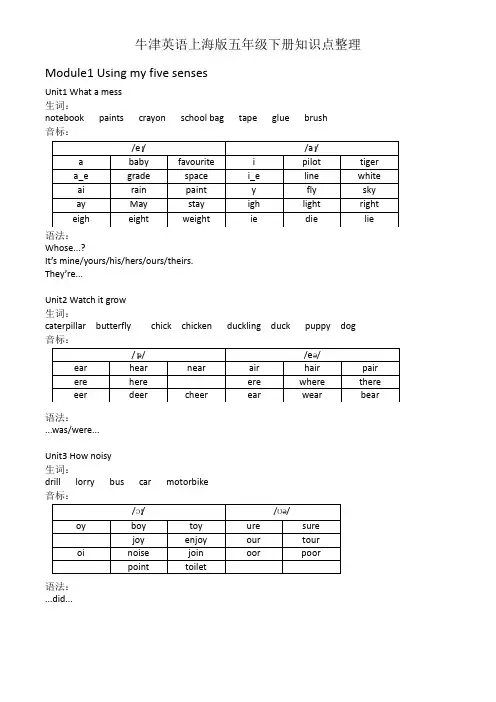
Module1 Using my five sensesUnit1 What a mess生词:notebook paints crayon school bag tape glue brush音标:语法:Whose...?It’s mine/yours/his/hers/ours/theirs.They’re...Unit2 Watch it grow生词:caterpillar butterfly chick chicken duckling duck puppy dog 音标:语法:...was/were...Unit3 How noisy生词:drill lorry bus car motorbike音标:语法:...did...Module2 My favorite thingsUnit1 Food and drinks生词:Meat: pork beef chicken fishVegetables: tomatoes potatoes carrots cabbages beans Fruit: apples oranges bananas grapesStaple Food: rice noodles breadDrinks: juice water milk tea音标:语法:What did you have for...?I had...Unit2 Film生词:ticket ticket office entrance exit seat音标:Shall we...Unit3 school subject生词:Chinese English Maths Art Music IT PE音标:It’s time for...Module3 Things around usUnit1 Signs生词:telephone toilet restaurant exit entranceNo smoking No swimming Don’t litter Don’t walk on the grass 音标:语法:What does this sign say/mean?It says/means we can/can’t/mustn’t/shouldn’t..Unit2 Weather生词:Cloud/cloudy sun/sunny rain/rainy wind/windysnow/snowy storm/stormy fog/foggy 30℃/thirty degrees音标:语法:What’s the weather like? What’s the temperature?It’s...(weather).It’s...(temperature).Unit3 Changes生词:Cupboard bookshelf bed mirror lamp cushion sofa 音标:语法:What can we do?Module4 More things to learnUnit1 Museum生词:Science museum art museum history museum Insect museum car museum railway museum 语法:Which museum do you want to visit?I want to visit ...Why?Because...Unit2 Western holiday生词:Christmas Easter Halloween Thanksgiving 语法:When is ...?It’s on ...What do people do on this holiday?Unit3 story time生词:giant castle。
牛津版五年级下册英语语法知识点
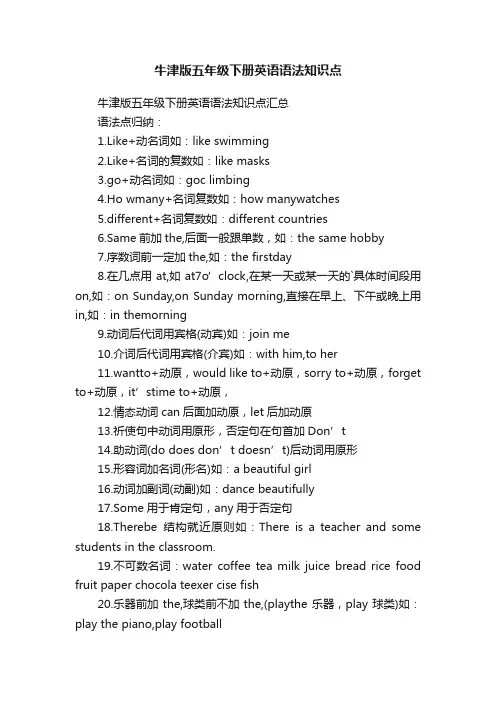
牛津版五年级下册英语语法知识点牛津版五年级下册英语语法知识点汇总语法点归纳:1.Like+动名词如:like swimming2.Like+名词的复数如:like masks3.go+动名词如:goc limbing4.Ho wmany+名词复数如:how manywatches5.different+名词复数如:different countries6.Same前加the,后面一般跟单数,如:the same hobby7.序数词前一定加the,如:the firstday8.在几点用at,如at7o’clock,在某一天或某一天的`具体时间段用on,如:on Sunday,on Sunday morning,直接在早上、下午或晚上用in,如:in themorning9.动词后代词用宾格(动宾)如:join me10.介词后代词用宾格(介宾)如:with him,to her11.wantto+动原,would like to+动原,sorry to+动原,forget to+动原,it’stime to+动原,12.情态动词can后面加动原,let后加动原13.祈使句中动词用原形,否定句在句首加Don’t14.助动词(do does don’t doesn’t)后动词用原形15.形容词加名词(形名)如:a beautiful girl16.动词加副词(动副)如:dance beautifully17.Some用于肯定句,any用于否定句18.Therebe结构就近原则如:There is a teacher and some students in the classroom.19.不可数名词:water coffee tea milk juice bread rice food fruit paper chocola teexer cise fish20.乐器前加the,球类前不加the,(playthe乐器,play球类)如:play the piano,play football21.Who当作特殊的第三人称单数。
上海牛津英语五年级下册语法点

上海牛津英语五年级下册语法点Document serial number【NL89WT-NY98YT-NC8CB-NNUUT-NUT108】上海牛津英语五年级下册语法点整理动词的形式:一、动词后面加上ing:①、现在进行时:表示某个动作正在发生或进行。
它的构成方式是:主语+be+动词ing〔现在分词〕形式,有时会要求自己加上be动词(is,am,are)。
句子中经常会出现look,listen,now……等词。
现在进行时的变化肯定句式:主语+be(am,is,are)+动词ing+其它.否定句式:主语+be(am,is,are)+not+动词ing+其它.一般疑问句:Be(am,is,are)+主语+动词ing+其它?特殊疑问句:疑问词(what,where…)+be(am,is,are)+主语+动词ing+其它?对现在进行时的特殊疑问句的回答,它不可以用Yes或No直接作答,要根据实际情况回答。
练习:1.Whatareyou_________(do)nowI___________(eat)bread.2.It’snineo’clock..Myfather_______________(work)intheoffice.3.Look,theboy____________(put)theplateonhisfinger.4.__________he__________(clean)theclassroomNo,heisn’t.He____________(play).5.WhereisMakHe___________(run)onthegrass.6.Listen,who___________(sing)inthemusicroomOh,Mary___________(sing)there.②like(s),go,dosome,后面的动词加ing.如:1.Ilike(play)football,butmyfatherlikes(play)chess.2.Let’sgo(swim).二、动词后面加s/es.这就有关一种时态:一般现在时。
2023年牛津译林版五年级英语下册全册语法资料
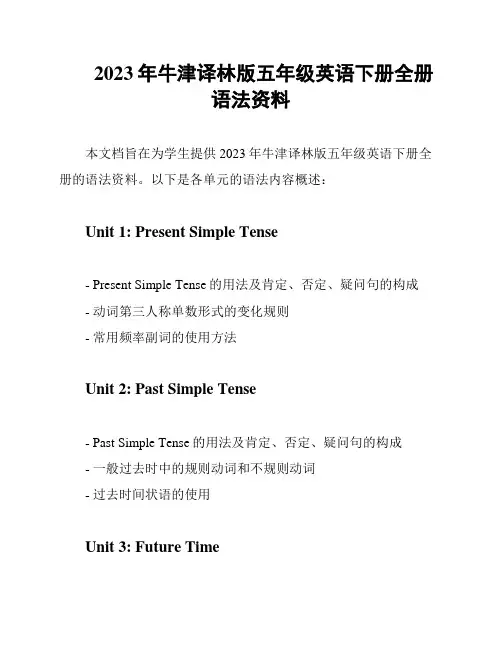
2023年牛津译林版五年级英语下册全册语法资料本文档旨在为学生提供2023年牛津译林版五年级英语下册全册的语法资料。
以下是各单元的语法内容概述:Unit 1: Present Simple Tense- Present Simple Tense的用法及肯定、否定、疑问句的构成- 动词第三人称单数形式的变化规则- 常用频率副词的使用方法Unit 2: Past Simple Tense- Past Simple Tense的用法及肯定、否定、疑问句的构成- 一般过去时中的规则动词和不规则动词- 过去时间状语的使用Unit 3: Future Time- 表示将来时间的常用词汇和短语- 表示将来意图或计划的句型结构- 表示将来打算的情态动词Unit 4: Verb Patterns- 动词后面接不定式的几种常见情况及用法- 动词后接动名词的特殊情况和常见动词短语- 动词后面接宾语从句的用法及连接词的选择Unit 5: Adjectives and Adverbs- 形容词的分类和用法- 副词的分类和用法- 形容词和副词的比较级和最高级形式Unit 6: Conditionals- 条件状语从句的类型和用法- 常用的条件状语从句连词- 条件状语从句中使用的虚拟语气形式Unit 7: Reported Speech- 直接引语和间接引语的转换规则- 时间和人称的变化- 连接词的选择和引号的使用Unit 8: Passive Voice- 被动语态的构成和用法- 被动语态中的时态变化- 被动句与主动句的转换Unit 9: Connecting Words- 表示结果的连词和短语- 表示原因和目的的连词和短语- 表示条件和让步的连词和短语该资料提供了每个单元的语法要点,旨在帮助学生巩固和扩展英语语法知识。
学生可以通过阅读和练这些资料来提高自己的语法水平。
请注意,本文档只提供了概述,并未列举详细的例句和练题。
知识清单(素材)沪教牛津版(深圳用)英语五年级下册(1)
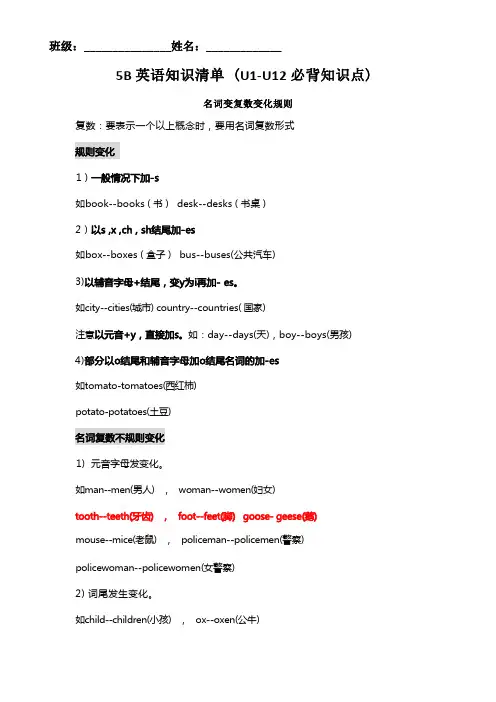
_____________ 5B复数:要表示一个以上概念时,要用名词复数形式如book--books ( 书 ) desk--desks ( 书桌 )如box--boxes ( 盒子 ) bus--buses(公共汽车)如city--cities(城市) country--countries( 国家)如:day--days(天),boy--boys(男孩)如tomato-tomatoes(西红杮)potato-potatoes(土豆)1) 元音字母发变化。
如man--men(男人) , woman--women(妇女)mouse--mice(老鼠) , policeman--policemen(警察) policewoman--policewomen(女警察)2) 词尾发生变化。
如child--children(小孩) , ox--oxen(公牛)3) 单、复数形式相同。
如fish--fish(鱼) ,sheep--sheep(绵羊) ,deer--deer(鹿) ,Chinese--Chinese(中国人) ,yuan--yuan(元) ,注意不说an English,要说an Englishman.①fish作鱼肉讲时不可数名词,没有复数。
②fishes指各种不同种类鱼或指几条鱼。
时间,He likes watching TV. 他喜欢看电视。
He doesn’t like watching TV.Does he like watching TV?Yes, he does. /// No, he doesn’tShe has lunch at twelve. 她十二点吃午餐。
She doesn’t have lunch at twelv e.Does she have lunch at twelve?Yes, she does. /// No, she doesn’t.It looks like a cat. 它看起来像只猫。
牛津小学五年级英语语法常识汇总
es
以“f 或 fe”结尾 变 f 或 fe 为 v, knife-knives
不规则名词复数
2、人称代词和物主代词 单数
再加-es
主格 宾格 主格
人称代词
例词
book-books bag-bags cat-cats bed-beds
bus-buses
box-boxes brush-brushes
watch-watches peach—peaches glass--
一、词类:
1、名词
五年级英语语法知识汇总
这里强调两点:不可数名词都默认为单数,所以总是用 is
名词复数如何加后缀:
各种不同情况
一般情况
以 s. x. sh. ch 加-es
结尾
变化方法
直接加-s
以“辅音字母 变 y 为 i, 再加- family-families study--studies
+y”结尾
第二人称 you(你) you
he(他) him they
you(你们)
第三人称 she(她) her (他/她/它 them her(她的) (他/她/它们
it(它) it
们)
人称代词: 有主格和宾格之分。 一般动词前用主格,动词后用宾格。
3、指示代词
指近处
单数 this (这个) that (那个)
glasses
man-men woman-women policeman-
policemen policewoman-policewomen mouse-
mice foot-feet child-children fish-fish
Chinese-Chinese
“牛津上海版”小学英语五年级(下)知识点大全
M odule1U sing my five sensesUnit1What a mess!词汇school bag书包brush刷paints颜料crayon蜡笔notebook笔记本glue胶水tape磁带put放置日常表达What a mess!好乱啊!What should I do?我应该做什么?语法1.特殊疑问句例Whose school bag is this?2.代词mine,yours,his,hers,ours,theirs3.祈使句例Put it on her desk,Peter.Unit2Watch it grow!词汇egg鸡蛋cocoon茧caterpillar毛毛虫butterfly蝴蝶chick小鸡chicken鸡duckling小鸭duck鸭子puppy小狗dog狗grow长大fly飞was是were是first首先next接下来then随后finally最后语法1.一般过去时例It was a white egg.2.一般现在时例Now it is a green caterpillar.Unit3How noisy!词汇drill钻(孔);打(眼)lorry卡车motorbike摩托车outside外面sleep睡觉another另外的noise噪音heard听到sat坐日常表达Not at all.一点也不。
语法1.特殊疑问句例What’s that noise?What can you hear?2.一般过去时例Kitty wanted to read a book.M odule2M y favourite thingsUnit1Food and drinks词汇meat肉pork猪肉beef牛肉chicken鸡肉fish鱼肉fruit水果vegetable蔬菜tomato西红柿potato土豆carrot胡萝卜cabbage卷心菜bean豆子rice米饭noodles面条bread面包water水milk牛奶tea茶orange橙子grape葡萄apple苹果banana香蕉drink饮料milk牛奶had有eat吃healthy健康的did做keep...away远离日常表达...is/are my favourite food.是我最喜欢的食物。
牛津译林英语小学五年级下册全册知识点梳理
the prince's house在王子的宫殿sad 如此伤心back回来to不得不every house拜访每一间屋子tales童话故事King 美猴王some mushrooms找到一些蘑菇a dress画一条连衣裙her friend 为她的朋友some snacks吃一些零食a drink喝一杯well 很合适看起来那么漂亮 so nice不能理解't understand想要做某事 like to do bad for us 对我们有害 off the shoes 脱下鞋子参加舞会 to the partyfairies 三个仙女 it on试穿它不得不走 to go twelve o'clock 在12点以前在那些聚会上 the parties美丽的衣服clotheslot of mushrooms许多蘑菇在树下 the treeon the shoe试穿鞋子 them 吃了它找到女孩 the girlcan't you…你为什么不能……behind丢下…up 赶快some drinks 找到一些饮料question words一些疑问词me 适合我a picture for me 为我画一幅画a drink喝一份饮料so nice 看起来那么漂亮at school 在校学习a story about…读一个有关…的故事42. pick a big and red mushroom采一个又大又红的蘑菇三、句子:and help me.过来帮我。
are you so sad, dear?亲爱的,为什么你这样伤心?I don't have any nice clothes or shoes.因为我没有任何漂亮的衣服和鞋子。
up!快点!can eat them.我们可以吃它们了。
a pity!真可惜!can't you go to the party?你为什么不能去参加舞会?foot hurts! 我的脚受伤了!like reading stories about the Monkey King and Nezha. 我喜欢读猴王和哪吒的故事。
上海 牛津英语五年级下册 语法点详解
上海牛津英语五年级下册语法点详解一、名词的单数和复数名词是指表示事物、人或概念等的名称。
名词有单数和复数形式。
名词的单数表示一个,复数表示多个。
一般情况下,在名词后面加-s可以变成复数形式,但也有一些特殊的规则需要注意。
示例:1.单数:dog(狗)2.复数:dogs(狗)二、动词的现在时态动词用来表示一个动作或状态。
动词有不同的时态,包括过去时态、现在时态和将来时态。
现在时态指的是现在正在发生的动作或状态。
示例:1.I eat an apple.(我吃一个苹果。
)2.___.(她步行去学校。
)三、形容词的比较级和最高级形容词用来描述事物的性质或特征。
形容词有比较级和最高级两种形式。
比较级用于比较两个事物的性质,最高级用于比较三个或更多事物的性质。
示例:1.This is a big book.(这是一本大书。
)2.That book is bigger than this one.(那本书比这本大。
)3.The yellow book is the biggest.(黄色的那本书是最大的。
)四、副词的用法副词是用来修饰动词、形容词或其他副词的词语。
它可以表示时间、地点、程度、方式等含义。
示例:1.___.(他慢慢地走。
)2.___.(她唱得很好听。
)3.They often go to the park.(他们经常去公园。
)五、代词的用法代词是用来代替名词的词语。
它可以指代一个或多个人或事物,有时也可以用来指代整个句子。
示例:1.I like this book。
It is interesting.(我喜欢这本书。
它很有趣。
)2.___.(他们是我的朋友。
我们一起玩。
)六、介词的用法介词是用来表示事物之间的关系的词语。
它通常用在名词或代词前面,用来说明名词或代词与其他词语之间的关系。
示例:1.The cat is on the table.(猫在桌子上。
)2.I went to the park with my friends.(我和我的朋友一起去了公园。
- 1、下载文档前请自行甄别文档内容的完整性,平台不提供额外的编辑、内容补充、找答案等附加服务。
- 2、"仅部分预览"的文档,不可在线预览部分如存在完整性等问题,可反馈申请退款(可完整预览的文档不适用该条件!)。
- 3、如文档侵犯您的权益,请联系客服反馈,我们会尽快为您处理(人工客服工作时间:9:00-18:30)。
英语语法知识汇总-五B 第一课时——名词复数重点:名词的复数变化规则。
难点:灵活运用。
这里强调两点:不可数名词都默认为单数,所以总是用is.1.一般+s 如map→maps , bag→bags 等2.特殊:以s,x,sh,ch 结尾的单词+es 如bus→buses , watch→watches 等;3.以辅音字母+y 结尾,去掉y 加上ies ,以元音字母+y 结尾加上s4.以f 或fe 结尾,去掉f/fe 加上ves 。
如 knife→knives leaf→leaves wolf→wolves wife→wives life→lives thief→thieves5.有时可数,有时不可数:典型例词:fish 当它解释为鱼肉时是不可数名词,当它解释成同一种鱼时,单复数同形,复数即为fish ,当它解释为不同一种鱼时,+es,即为fishes.6.以o 结尾,a) photo→photos ,piano→pianos,radio→radios ,zoo→zoos b )加es 的名词有:potato→potatoes tomato→tomatoes7.特殊词:child---children(小孩) man--men (男人) woman--women(女人) 8.单复数同形(单数和复数一样)people(人)sheep(绵羊) deer (鹿)) 9.国人变复数 :口诀:中日不变英法变,其余s 加后面。
Chinese--Chinese Japanese--JapaneseEnglishman--Englishmen Frenchman--Frenchmen American--Americans 等等10. 字母、数字、引语、缩略语变复数,在其后加s 或's 。
eg. There are two t's in the word “bottle".各种不同情况 变化方法 例词一般情况直接加-sbook-books bag-bags cat-cats bed-beds 以s. x. sh. ch结尾加-esbus-buses box-boxes brush-brushes watch-watches peach —peaches glass--glasses以“辅音字母+y”结尾变y 为i, 再加-es family-families study--studies以“f 或fe”结尾变f 或fe 为v ,再加-esknife-knives不规则名词复数man-men woman-women policeman-policemen policewoman-policewomen mouse-mice foot-f eet child-children fish-fish Chinese-ChineseThere are two 1's i n the number “2011".一、用所给的单词的复数的正确形式填空: 1> There are three ______(chair) in the classroom. 2>These _______(tomato) are red.3>My brother looks after two ______(baby) 4> My father likes to eat _______(potato). 5>Chinese ______(people)like to eat noodles. 6>I have a lot of ______(toy) in my bedroom.7>I help my mother wash ______(dish) in the kitchen. 8>I have two ______(pencil-box).9>There are some ______(bus)in the street. 10>Peter has eight _____(foot). 二、选择填空( )1.I can see three ________ in the zoo. A monkeys B monkeyes C monkey ( )2.The pig has four ______. A. foot B. feet C. foots( )3.My two brothers are both ______. A. policeman B. policemans C. policemen ( )4.I can see ten _____ in the picture. A. sheep B. dog C. pig( )5.The _____ has three__. A. boys, watches B. boy, watch C. boy, watches ( )6.Can you see _______on the plate? A. bread B. breads C. breades( )7.The girl often brushes her_____ before she goes to bed. A. tooth B. tooths C. teeth ( )8.Mr Black often drink some _________.A. milk B. milks kes ( )9.There are some _____on the floor. A. child B. water C. books( )10..Lucy will show us some new ____ of hers. A. photo B. photos C. Photoes 第二课时——2、人称代词和物主代词重点:区分人称代词和物主代词。
难点:词性。
人称代词:有主格和宾格之分。
一般动词前用主格,动词后用宾格。
一、用适当的人称代词填空:1. __________ is my aunt. we often visit __________. ( she )2. china is a developing country. _________is in the east of asia. ( its )3. what day is __________ today? — __________ is thursday. (its)人称代词物主代词 单数 复数 单数复数 主格宾格 主格宾格 形容词性形容词性第一人称 I (我)mewe (我们) us my (我的) our (我们的) 第二人称 you (你) youyou (你们) you your (你的) your (你们的) 第三人称 he (他)himthey(他/她/它们)them his (他的)their (他/她/它们的)she (她) herher (她的) it (它)itit (它的)5. i own a blue bike. the red one isn’t __________. ( i )二、用形容词性物主代词和名词性物主代词填空1. i ate all ____ sandwiches yesterday.( i ) can i have one of ____ ? ( you )2. george has lost ____ ( his ) pen. ask mary if(是否)she will lend him ____ . ( she )3.. jack has a dog and so have i. ____ ( he ) dog and ___( i ) had a fight (打架).4. the teacher wants you to return that book of ____ ( he )5. mr. and mrs. green and a friend of ____ are coming to see us. ( they )三、用适当的人称代词和物主代词填空a. 从括号内选择正确的代词填空1. your football clothes are on the desk.please put _________(they,them,their,theirs) away.2. (we,us,our,ours)_________ english teacher is mrs. green.we all like _________(she,her,hers).3. (i,me,my,mine)_________ can’t get my kite.could you help _________(i,me,my,mine)?b. 填入正确的人称代词和物主代词1. this isn’t________knife. _________ is green. ( she )2. these are your books,kate. put __________ in the desk,please. (they )3. _______ must look after ________ things. ( you )4. wei fang,is that ________ ruler? yes,it’s.( you )5. they want a football. give __________ the green one,please. ( they)四、用括号中的适当形式填空(1)are these ________(you)pencils?yes, they are ________(our).(2)—whose is this pencil?—it’s ________(i).(3)i love ________(they)very much.(4)she is________(i)classmate.第三课时——冠词指近处指远处单数this (这个)that (那个)复数these(这些)those(那些)有a、an、the。
a和an的区别:an用于元音音素(一般就是元音字母a、e、i、o、u)前,a用于辅音音素前。
基本用法——当代语法把冠词分为不定冠词、定冠词和零冠词(即不用冠词)三种。
冠词是一种虚词,起限定作用,是最主要最典型的限定词,放在名词(或名词化的形容词分词)前面,说明其所指的人或物。
此类问题很多人都会陷入误区,认为见到a,e,i,o,u前面就该用不定冠词an,如果不是就用a,这是不对的哦,其实正确的理解应该是当单个字母或单词发音以元音开头就用an,否则用a,可以说当用an时与是否出现元音字母无关。
